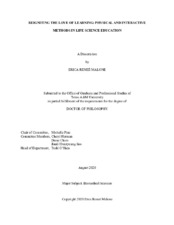| dc.description.abstract | A foundational understanding of basic concepts in the life sciences is crucial to the success of pre-professional and professional health-care students. Educational theories such as the Zone of Proximal Development, Cognitive Load Theory, Experiential Learning Theory, and Constructivism can help instructors to design and implement tools that are more effective in supporting student learning of these crucial concepts. These theories also bring light to issues with current instructional tools including a lack of dynamic, tactile, or interactive elements. In an attempt to resolve these issues with tools which address solutions proposed in educational psychology, a physically interactive model was designed and constructed. This model included components which demonstrate concepts across different life-science disciplines including gross anatomy, histology, physiology, and kinesiology. A study of the effect and influence of the model was conducted in a large undergraduate Biomedical Anatomy course and compared to various other instructional methods. Results showed that students in all groups (control, activity control and intervention) experienced changes in attitudes, motivations and study methods throughout the study – most of which were positive changes. All students made significant improvements between preliminary and post quizzes, however the improvement for both the control group and the intervention group were significantly higher than the activity control group for two topics assessed. Considering the consistently higher performance of the control group and consistently lower performance of the intervention group, the improvements in quiz scores for the intervention group could be attributed to interaction with the model, although further study is required. In addition, qualitative results showed that students perceived interaction with the model as both enjoyable and beneficial to their learning. | en |


